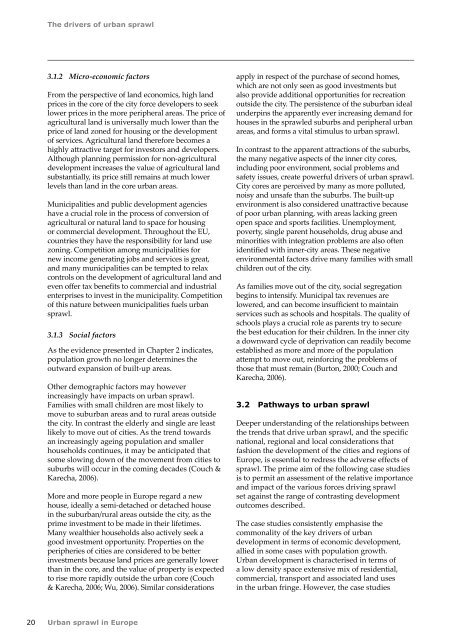Session 1 - Montefiore
Session 1 - Montefiore
Session 1 - Montefiore
You also want an ePaper? Increase the reach of your titles
YUMPU automatically turns print PDFs into web optimized ePapers that Google loves.
20<br />
The drivers of urban sprawl<br />
3.1.2 Micro-economic factors<br />
From the perspective of land economics, high land<br />
prices in the core of the city force developers to seek<br />
lower prices in the more peripheral areas. The price of<br />
agricultural land is universally much lower than the<br />
price of land zoned for housing or the development<br />
of services. Agricultural land therefore becomes a<br />
highly attractive target for investors and developers.<br />
Although planning permission for non-agricultural<br />
development increases the value of agricultural land<br />
substantially, its price still remains at much lower<br />
levels than land in the core urban areas.<br />
Municipalities and public development agencies<br />
have a crucial role in the process of conversion of<br />
agricultural or natural land to space for housing<br />
or commercial development. Throughout the EU,<br />
countries they have the responsibility for land use<br />
zoning. Competition among municipalities for<br />
new income generating jobs and services is great,<br />
and many municipalities can be tempted to relax<br />
controls on the development of agricultural land and<br />
even offer tax benefits to commercial and industrial<br />
enterprises to invest in the municipality. Competition<br />
of this nature between municipalities fuels urban<br />
sprawl.<br />
3.1.3 Social factors<br />
As the evidence presented in Chapter 2 indicates,<br />
population growth no longer determines the<br />
outward expansion of built-up areas.<br />
Other demographic factors may however<br />
increasingly have impacts on urban sprawl.<br />
Families with small children are most likely to<br />
move to suburban areas and to rural areas outside<br />
the city. In contrast the elderly and single are least<br />
likely to move out of cities. As the trend towards<br />
an increasingly ageing population and smaller<br />
households continues, it may be anticipated that<br />
some slowing down of the movement from cities to<br />
suburbs will occur in the coming decades (Couch &<br />
Karecha, 2006).<br />
More and more people in Europe regard a new<br />
house, ideally a semi-detached or detached house<br />
in the suburban/rural areas outside the city, as the<br />
prime investment to be made in their lifetimes.<br />
Many wealthier households also actively seek a<br />
good investment opportunity. Properties on the<br />
peripheries of cities are considered to be better<br />
investments because land prices are generally lower<br />
than in the core, and the value of property is expected<br />
to rise more rapidly outside the urban core (Couch<br />
& Karecha, 2006; Wu, 2006). Similar considerations<br />
Urban sprawl in Europe<br />
apply in respect of the purchase of second homes,<br />
which are not only seen as good investments but<br />
also provide additional opportunities for recreation<br />
outside the city. The persistence of the suburban ideal<br />
underpins the apparently ever increasing demand for<br />
houses in the sprawled suburbs and peripheral urban<br />
areas, and forms a vital stimulus to urban sprawl.<br />
In contrast to the apparent attractions of the suburbs,<br />
the many negative aspects of the inner city cores,<br />
including poor environment, social problems and<br />
safety issues, create powerful drivers of urban sprawl.<br />
City cores are perceived by many as more polluted,<br />
noisy and unsafe than the suburbs. The built-up<br />
environment is also considered unattractive because<br />
of poor urban planning, with areas lacking green<br />
open space and sports facilities. Unemployment,<br />
poverty, single parent households, drug abuse and<br />
minorities with integration problems are also often<br />
identified with inner-city areas. These negative<br />
environmental factors drive many families with small<br />
children out of the city.<br />
As families move out of the city, social segregation<br />
begins to intensify. Municipal tax revenues are<br />
lowered, and can become insufficient to maintain<br />
services such as schools and hospitals. The quality of<br />
schools plays a crucial role as parents try to secure<br />
the best education for their children. In the inner city<br />
a downward cycle of deprivation can readily become<br />
established as more and more of the population<br />
attempt to move out, reinforcing the problems of<br />
those that must remain (Burton, 2000; Couch and<br />
Karecha, 2006).<br />
3.2 Pathways to urban sprawl<br />
Deeper understanding of the relationships between<br />
the trends that drive urban sprawl, and the specific<br />
national, regional and local considerations that<br />
fashion the development of the cities and regions of<br />
Europe, is essential to redress the adverse effects of<br />
sprawl. The prime aim of the following case studies<br />
is to permit an assessment of the relative importance<br />
and impact of the various forces driving sprawl<br />
set against the range of contrasting development<br />
outcomes described.<br />
The case studies consistently emphasise the<br />
commonality of the key drivers of urban<br />
development in terms of economic development,<br />
allied in some cases with population growth.<br />
Urban development is characterised in terms of<br />
a low density space extensive mix of residential,<br />
commercial, transport and associated land uses<br />
in the urban fringe. However, the case studies











